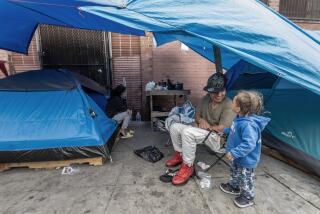Ventura County Welfare Cases Jump 11% : Public assistance: The slow economy, the drought and the December freeze are blamed for the increase over a 10-month period.
The number of households receiving welfare assistance in Ventura County jumped by 11% during a 10-month period ending in April, the largest increase since the recession of the early 1980s, county officials said.
The number of recipients of funds from the Aid to Families with Dependent Children program and from the county’s General Relief program increased from 7,473 in July, 1990, to 8,296 by the end of April, 1991.
The increase in welfare cases is attributed mostly to the continuing recession that has gripped much of the nation, Helen Reburn, deputy director of the county’s Public Social Services Agency, said last week.
To make matters worse, Southern California’s five-year drought and the December freeze have continued to hurt the county’s agriculture industry, she said. “We haven’t seen any letup.”
Reburn said she expects the number of welfare cases to continue to climb although some economists say there have been signs that the economy is recovering. In Ventura County, the jobless rate in April dropped to 6.1% from 7% a month earlier.
“My guess is that it will be a while before it trickles down to our recipients,” she said.
The largest increase in AFDC cases has been among two-parent households requesting assistance because one or both parents are out of work. Those cases increased from 607 in July, 1990, to 919 in April, she said.
During the 10 months ending in April, the monthly assistance paid out through the county in AFDC and General Relief funds has increased by 16% to $4.9 million in April, she said.
Caught off-guard by the dramatic increases, Reburn has been forced to request that the Board of Supervisors increase the budget for her agency three times in the past four months.
After her latest request last Tuesday, the supervisors agreed to increase the agency’s budget by $179,500 for the rest of the fiscal year that ends July 1.
The AFDC program is funded 50% by the federal government, 45% by the state and 5% by the county. The General Relief program, which provides loans and grants to people who do not qualify for other aid, is funded entirely by the county.
AFDC funds are paid according to the number of children in a family.
Reburn said the size of the families seeking assistance has increased, which has also played a role in increasing the welfare budget. For example, in March, 1990, the average family received $596 a month in AFDC funds. In March, 1991, the average family received $608 a month.
Among those added to the welfare rolls this year was Carmen Velasquez, a single mother of six from Oxnard.
She said she lost her job as a cocktail waitress in March when the bar where she worked fell on hard economic times.
Because the AFDC payments that she receives are not enough to pay the rent on an apartment, Velasquez said she and three of her youngest children live in a hotel. Her three older children live in Mexico with their grandmother, she said.
“The rents are just sky-high,” she said.
Sylvia Gonzalez, a caseworker at the Public Social Services Agency offices in Oxnard, said Velasquez’s situation is unfortunate but not uncommon.
“We had one man who was let go from his job at a packinghouse after 26 years at the same place,” she said. “He felt very awkward because he had never done anything else and no one wanted to hire him because of his age.”
But the case that sticks most in Gonzalez’s mind is that of an elderly woman who asked for welfare assistance to support herself and her teen-age grandson.
During the Christmas season, Gonzalez said she asked the woman what she wanted most for Christmas. “She said ‘I want life,’ ” Gonzalez said.
Gonzalez found out later that the woman was dying of cancer. “She couldn’t tell her grandson about it because she was all he had,” Gonzalez said.
More to Read
Sign up for Essential California
The most important California stories and recommendations in your inbox every morning.
You may occasionally receive promotional content from the Los Angeles Times.











